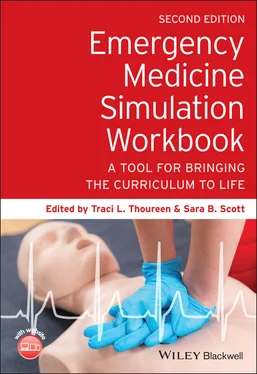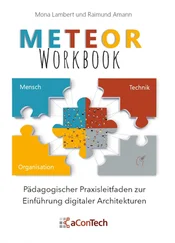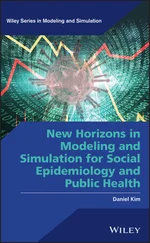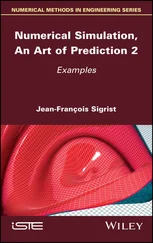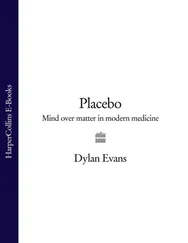Emergency Medicine Simulation Workbook
Здесь есть возможность читать онлайн «Emergency Medicine Simulation Workbook» — ознакомительный отрывок электронной книги совершенно бесплатно, а после прочтения отрывка купить полную версию. В некоторых случаях можно слушать аудио, скачать через торрент в формате fb2 и присутствует краткое содержание. Жанр: unrecognised, на английском языке. Описание произведения, (предисловие) а так же отзывы посетителей доступны на портале библиотеки ЛибКат.
- Название:Emergency Medicine Simulation Workbook
- Автор:
- Жанр:
- Год:неизвестен
- ISBN:нет данных
- Рейтинг книги:3 / 5. Голосов: 1
-
Избранное:Добавить в избранное
- Отзывы:
-
Ваша оценка:
- 60
- 1
- 2
- 3
- 4
- 5
Emergency Medicine Simulation Workbook: краткое содержание, описание и аннотация
Предлагаем к чтению аннотацию, описание, краткое содержание или предисловие (зависит от того, что написал сам автор книги «Emergency Medicine Simulation Workbook»). Если вы не нашли необходимую информацию о книге — напишите в комментариях, мы постараемся отыскать её.
Emergency Medicine Simulation Workbook
Emergency Medicine Simulation Workbook — читать онлайн ознакомительный отрывок
Ниже представлен текст книги, разбитый по страницам. Система сохранения места последней прочитанной страницы, позволяет с удобством читать онлайн бесплатно книгу «Emergency Medicine Simulation Workbook», без необходимости каждый раз заново искать на чём Вы остановились. Поставьте закладку, и сможете в любой момент перейти на страницу, на которой закончили чтение.
Интервал:
Закладка:
Broad‐spectrum intravenous antibiotics.
Intravenous fluids.
Surgical intervention, if pneumatosis is present.
Survival rates depend on disease severity:Those requiring surgical management have worse outcomes with mortality, around 35%.If treated medically, mortality is around 20%.
Debriefing Plan
Allow approximately 20–30 minutes for debriefing after this scenario.
Potential Questions for Discussion
What are pertinent history and physical exam findings in a vomiting neonate/infant?
What is the differential diagnosis of bilious compared with nonbilious vomiting in neonates?
If unable to obtain peripheral IV access in an infant, what alternatives are available for fluid resuscitation?
What is the management for an infant with NEC?
REFERENCES FOR NECROTIZING ENTEROCOLITIS
1 1. Shields, T.M. and Lightdale, J.R. (2018). Vomiting in children. Pediatr. Rev. 39 (7): 342–358.
2 2. Rich, B. and Dolgin, S. (2017). Necrotizing enterocolitis. Pediatr. Rev. 38 (12): 552–559.
3 3. Burge, D. (2016). The management of bilious vomiting in the neonate. Early Hum. Dev. 102: 41–45.
4 4. Frost, B., Modi, B., Jaksic, T. et al. (2017). New medical and surgical insights into neonatal necrotizing enterocolitis. JAMA Pediatr. 171 (1): 83.
5 5. Ratnayake, K. and Kim, T.Y. (2014). Evidence‐based management of neonatal vomiting in the emergency department. Pediatr. Emerg. Med. Pract. 11 (11): 1–20.
ACUTE ASCENDING CHOLANGITIS
Educational Goals
Learning Objectives
1 Demonstrate focused history and physical examination skills (PC, MK).
2 Identify the need for blood work and imaging studies (MK).
3 Recognize signs and symptoms of sepsis (MK).
4 Initiate appropriate management of sepsis (MK, PC).
5 Demonstrate appropriate consultation for acute cholangitis (MK, ICS, P, SBP)
6 Demonstrate ability to obtain collateral history from family members, emergency medical services (EMS), and/or nursing home staff, for a patient who is unable to provide a history (ICS, P, SBP).
Critical Actions Checklist
Obtain IV access (PC).
Administer IV fluids (30 cc/kg IV fluid bolus) (MK, PC).
Administer broad‐spectrum IV antibiotics (MK, PC).
Obtain computed tomography (CT) to evaluate for causes of acute abdominal pain and to rule out life‐threatening pathology (MK, PC).
Consult general surgery and/or gastroenterology (ICS, P, SBP).
Simulation Set‐Up
| Environment: | Emergency department resuscitation room. |
This scenario may begin on scene at the patient's home with EMS gathering information from family, then transition to the ED.
| Mannequin: | Adult male simulator mannequin, with wig (gray hair if possible), fully dressed. Sclera should be icteric; this can be moulaged using a yellow erasable marker or removable yellow translucent film. |
| Props: | To be displayed on screen or given as handouts when asked for/returned from lab: |
Images (see online component for acute cholangitis, Scenario 1.2 at https://www.wiley.com/go/thoureen/simulation/workbook2e):Chest x‐ray showing no active pulmonary disease ( Figure 1.6).Radiology reading of chest x‐ray (normal) ( Figure 1.7).Head CT (static image 1‐cut) showing no intracranial abnormality ( Figure 1.8).Radiology read CT head (normal) ( Figure 1.9).Ultrasound of right upper quadrant (static image) showing biliary dilation ( Figure 1.10).Radiology read showing biliary dilation concerning for choledocholithiasis ( Figure 1.11).CT abdomen/pelvis with IV contrast (static image, 1‐cut) showing grossly dilated common bile duct ( Figure 1.12).CT read concerning for acute cholangitis ( Figure 1.13).Electrocardiogram (ECG) showing sinus tachycardia ( Figure 1.14).
Laboratory tests (see online component as above):Complete blood count ( Table 1.12).Basic metabolic panel ( Table 1.13).Liver function panel ( Table 1.14).Lipase ( Table 1.15).Lactic acid ( Table 1.16).Coagulation panel ( Table 1.17).Troponin ( Table 1.18).Type and screen ( Table 1.19).Urinalysis ( Table 1.20).Urine microscopy ( Table 1.21).
Available supplies:
Adult code cart with basic airway supplies.
Central line kit (triple lumen).
Medications:0.9% saline, LR IV bags.Pre‐labeled IV bags.IV vasopressor infusion (norepinephrine or similar).Broad‐spectrum antibiotics.Pre‐labeled syringes:Antiemetics (ondansetron, metoclopramide).Analgesic medications (morphine, fentanyl, hydromorphone).Rapid sequence intubation medications (sedative/paralytics typical to your institution).
Distractor: none
Actors
The patient is slightly confused as to the timeline of events/illness, but able to answer some questions. Occasionally moans due to abdominal pain. May have dry heaving if no antiemetics are ordered.
EMS to share information gathered from family regarding how long he has been sick, what symptoms they have noticed (significantly less energetic and interactive, slow to respond to basic questions).
ED nurse can cue the learners if needed to progress the case.
Family member (patient's adult child) available by phone.
General surgery and/or gastroenterology available for phone consultation.
Admitting physician available for phone consultation.
Case Narrative
Scenario Background
A 60‐year‐old man presents for gradually worsening confusion over the course of two to three days. He reports having mild diffuse abdominal pain that is most severe in the upper abdomen. Over the course of the past one to two days, pain has become worse and he has begun to have vomiting and increased confusion.
| Chief complaint: | Confusion. |
| Patient's medical history: | Hypertension, diabetes, stroke. |
| Surgical istory: | Appendectomy, hernia repair. |
| Allergies: | None. |
| Social history: | Previous cigarette smoker; no alcohol or drug use. |
| Family history: | Non‐contributory. |
| Medications: | Lisinopril, metformin, aspirin, clopidogrel. |
Initial Scenario Conditions
A 60‐year‐old man is brought in by EMS from home. Patient is moaning due to abdominal pain, complaining of feeling sick.
| Vital signs: | Temp 102.5°F (39.2°C), HR 125, RR 22, BP 80/60, SpO2 99% on room air. |
| Head: | Atraumatic, normocephalic. |
| Eyes: | Icteric sclerae; pupils 4 mm bilaterally and reactive to light; extraocular movement intact without nystagmus. |
| Ears/nose/mouth: | Dry mucous membranes, with subungual icterus (if asked). |
| Neck: | Supple, full range of movement, no meningeal signs. |
| Heart: | Tachycardic, regular, no murmurs/rubs/gallops. |
| Lungs: | Clear to auscultation bilaterally (patient reports worsening belly pain when taking deep breaths). |
| Abdomen: | Distended, with hypoactive bowel sounds. Tender to palpation in the upper abdomen, most significant in the right upper quadrant and epigastric region. No rebound. Voluntary guarding in all quadrants. |
| Extremities: | No edema, cyanosis, or clubbing. |
| Skin: | Warm to the touch. |
| Neurologic: | Alert and oriented to person and place, but not to time. Answers most questions appropriately but seems confused and takes a while to respond to simple questions. No focal deficits. Cranial nerves intact. No asterixis. |
Physical exam findings that are not available on your mannequin may be offered verbally to learners if they ask (e.g. if unable to simulate icteric sclera, can verbally report the scleral exam to the learners if they specifically ask for this information).
Читать дальшеИнтервал:
Закладка:
Похожие книги на «Emergency Medicine Simulation Workbook»
Представляем Вашему вниманию похожие книги на «Emergency Medicine Simulation Workbook» списком для выбора. Мы отобрали схожую по названию и смыслу литературу в надежде предоставить читателям больше вариантов отыскать новые, интересные, ещё непрочитанные произведения.
Обсуждение, отзывы о книге «Emergency Medicine Simulation Workbook» и просто собственные мнения читателей. Оставьте ваши комментарии, напишите, что Вы думаете о произведении, его смысле или главных героях. Укажите что конкретно понравилось, а что нет, и почему Вы так считаете.
